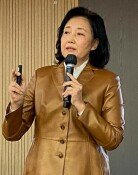Trump pledges to expand U.S. military intervention in N. Korea
Trump pledges to expand U.S. military intervention in N. Korea
Posted August. 23, 2017 08:50,
Updated August. 23, 2017 09:03
The U.S. Pacific Command, Strategic Command and Missile Defense Agency Director, who are responsible for protecting South Korea in case of war on the Korean Peninsula, held a joint press conference Tuesday and said that provocations of North Korea are dangerous to both South Korea and the U.S. The top military leaders in military uniform pledged to defend the Korean Peninsula by mobilizing all strategic assets and military capabilities of the U.S., while warning North Korean leader Kim Jong Un to make the right decision. The leadership visited the base in Seongju, North Gyeongsang Province where THAAD was deployed after the press conference to reaffirm their commitment to defense against provocations of North Korea and express their high expectations on prompt deployment of THAAD.
The U.S. Pacific Command is the largest of the nine unified combatant commands whose responsibility encompasses about half the earth’s surface. The Command is in charge of most U.S. support troops in case of war on the Korean Peninsula. The Strategic Command who controls the nuclear capability of the U.S. decides the deployment of strategic weapons on the Korean Peninsula. The Missile Defense Agency director is responsible for increasing the U.S. missile defense capability such as THAAD and Patriot missiles. The fact that the top U.S. military leaders simultaneously visited Seoul and held the joint press conference within one week after Joint Chiefs Chairman Gen. Joseph Dunford visited the nation is a strong warning against the North and a symbol of trust on the U.S.-South Korea alliance.
South Korean President Moon Jae-in stressed anti-war and peace at Tuesday’s meeting with visiting U.S. senators and lawmakers, saying, "Military option with even a limited scope could bring armed conflicts between South and North Korea and threaten lives of South Koreans, foreigners and the U.S. forces in South Korea." However, the way things are turning out in the U.S. seems to be serious. U.S. President Donald Trump announced on Monday that he would commit more U.S. troops to Afghanistan. It is a serious matter as Trump has vowed to change his stance from isolationism to active intervention, and this can also happen in South Korea. The Trump administration has replaced Chief Secretary, National Security Advisor, Defense Secretary and CIA Director with military personnel.
According to American media, the Ulchi-Freedom Guardian (UFG) military drills, which had been conducted based on a conventional war game scenario, has included nuclear war, chemical warfare, cyber war, and Kim Jong Un assassination operation this year as the Trump administration wanted to warn the North that "military option" does exist with this exercise. The New York Time also reported on Sunday that the talk of preventive war rises in the White House over North Korea. Here, a preventive war is a concept to prevent a total war with a preemptive strike.
Still, North Korea unveiled a video of its threat to fire missiles near Guam as it threatened the U.S. and South Korea with “merciless revenge” for Tuesday’s UFG training. It is Kim Jong Un who caused the crisis on the Korean Peninsula. It is highly likely that Kim would be the next target of U.S. President Trump who pledged to expand U.S. military intervention. Peace must be kept, but peace without power is a house built on the sand. It is time for us to be vigilant and solidify our determination.







